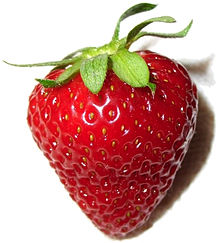Strawberries
| Garden strawberry Fragaria × ananassa |
|
|---|---|
 |
|
| Strawberry fruit | |
 |
|
| Strawberry fruit cross section | |
| Scientific classification | |
| Kingdom: | Plantae |
| (unranked): | Angiosperms |
| (unranked): | Eudicots |
| (unranked): | Rosids |
| Order: | Rosales |
| Family: | Rosaceae |
| Subfamily: | Rosoideae |
| Genus: | Fragaria |
| Species: | F. × ananassa |
| Binomial name | |
|
Fragaria × ananassa Duchesne |
|
| Nutritional value per 100 g (3.5 oz) | |
|---|---|
| Energy | 136 kJ (33 kcal) |
|
7.68 g
|
|
| Sugars | 4.89 g |
| Dietary fiber | 2 g |
|
0.3 g
|
|
|
0.67 g
|
|
| Vitamins | |
| Thiamine (B1) |
(2%)
0.024 mg |
| Riboflavin (B2) |
(2%)
0.022 mg |
| Niacin (B3) |
(3%)
0.386 mg |
| Pantothenic acid (B5) |
(3%)
0.125 mg |
| Vitamin B6 |
(4%)
0.047 mg |
| Folate (B9) |
(6%)
24 μg |
| Choline |
(1%)
5.7 mg |
| Vitamin C |
(71%)
58.8 mg |
| Vitamin E |
(2%)
0.29 mg |
| Vitamin K |
(2%)
2.2 μg |
| Minerals | |
| Calcium |
(2%)
16 mg |
| Iron |
(3%)
0.41 mg |
| Magnesium |
(4%)
13 mg |
| Manganese |
(18%)
0.386 mg |
| Phosphorus |
(3%)
24 mg |
| Potassium |
(3%)
153 mg |
| Sodium |
(0%)
1 mg |
| Zinc |
(1%)
0.14 mg |
| Other constituents | |
| Water | 90.95 g |
| Fluoride | 4.4 µg |
|
|
|
|
|
| Percentages are roughly approximated using US recommendations for adults. Source: USDA Nutrient Database |
|
The garden strawberry (or simply strawberry; Fragaria × ananassa) is a widely grown hybrid species of the genus Fragaria (collectively known as the strawberries). It is cultivated worldwide for its fruit. The fruit (which is not a botanical berry, but an aggregate accessory fruit) is widely appreciated for its characteristic aroma, bright red color, juicy texture, and sweetness. It is consumed in large quantities, either fresh or in such prepared foods as preserves, fruit juice, pies, ice creams, milkshakes, and chocolates. Artificial strawberry flavorings and aromas are also widely used in many products like lip gloss, candy, hand sanitizers, perfume, and many others.
The garden strawberry was first bred in Brittany, France, in the 1750s via a cross of Fragaria virginiana from eastern North America and Fragaria chiloensis, which was brought from Chile by Amédée-François Frézier in 1714.Cultivars of Fragaria × ananassa have replaced, in commercial production, the woodland strawberry (Fragaria vesca), which was the first strawberry species cultivated in the early 17th century.
Technically, the strawberry is an aggregate accessory fruit, meaning that the fleshy part is derived not from the plant's ovaries but from the receptacle that holds the ovaries. Each apparent "seed" (achene) on the outside of the fruit is actually one of the ovaries of the flower, with a seed inside it.
...
Wikipedia

